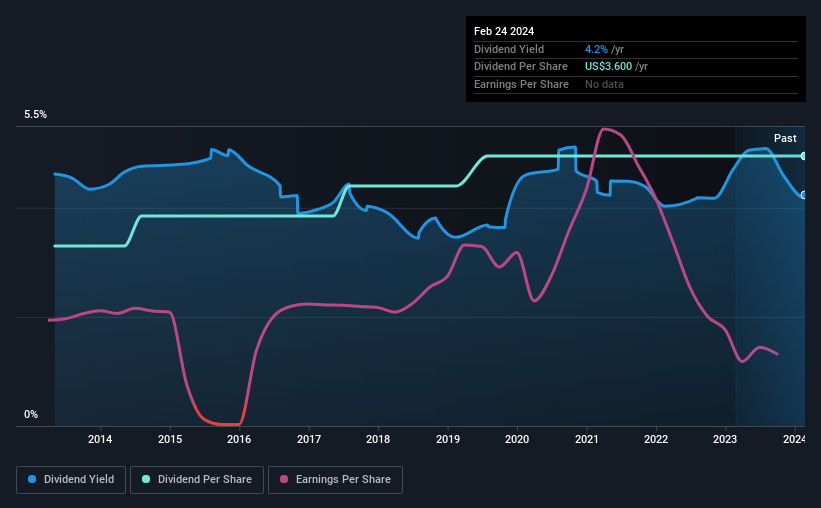Why It Might Not Make Sense To Buy Safety Insurance Group, Inc. (NASDAQ:SAFT) For Its Upcoming Dividend
Regular readers will know that we love our dividends at Simply Wall St, which is why it's exciting to see Safety Insurance Group, Inc. (NASDAQ:SAFT) is about to trade ex-dividend in the next four days. The ex-dividend date is usually set to be one business day before the record date which is the cut-off date on which you must be present on the company's books as a shareholder in order to receive the dividend. The ex-dividend date is an important date to be aware of as any purchase of the stock made on or after this date might mean a late settlement that doesn't show on the record date. In other words, investors can purchase Safety Insurance Group's shares before the 29th of February in order to be eligible for the dividend, which will be paid on the 15th of March.
The company's upcoming dividend is US$0.90 a share, following on from the last 12 months, when the company distributed a total of US$3.60 per share to shareholders. Last year's total dividend payments show that Safety Insurance Group has a trailing yield of 4.2% on the current share price of US$84.97. Dividends are an important source of income to many shareholders, but the health of the business is crucial to maintaining those dividends. That's why we should always check whether the dividend payments appear sustainable, and if the company is growing.
See our latest analysis for Safety Insurance Group
Dividends are typically paid out of company income, so if a company pays out more than it earned, its dividend is usually at a higher risk of being cut. Safety Insurance Group paid out 170% of profit in the past year, which we think is typically not sustainable unless there are mitigating characteristics such as unusually strong cash flow or a large cash balance.
When a company pays out a dividend that is not well covered by profits, the dividend is generally seen as more vulnerable to being cut.
Click here to see how much of its profit Safety Insurance Group paid out over the last 12 months.
Have Earnings And Dividends Been Growing?
Businesses with shrinking earnings are tricky from a dividend perspective. If earnings fall far enough, the company could be forced to cut its dividend. Safety Insurance Group's earnings per share have fallen at approximately 13% a year over the previous five years. When earnings per share fall, the maximum amount of dividends that can be paid also falls.
Another key way to measure a company's dividend prospects is by measuring its historical rate of dividend growth. In the past 10 years, Safety Insurance Group has increased its dividend at approximately 4.1% a year on average. That's intriguing, but the combination of growing dividends despite declining earnings can typically only be achieved by paying out a larger percentage of profits. Safety Insurance Group is already paying out 170% of its profits, and with shrinking earnings we think it's unlikely that this dividend will grow quickly in the future.
To Sum It Up
From a dividend perspective, should investors buy or avoid Safety Insurance Group? Earnings per share are in decline and Safety Insurance Group is paying out what we feel is an uncomfortably high percentage of its profit as dividends. It's not that we hate the business, but we feel that these characeristics are not desirable for investors seeking a reliable dividend stock to own for the long term. All things considered, we're not optimistic about its dividend prospects, and would be inclined to leave it on the shelf for now.
With that in mind though, if the poor dividend characteristics of Safety Insurance Group don't faze you, it's worth being mindful of the risks involved with this business. To that end, you should learn about the 3 warning signs we've spotted with Safety Insurance Group (including 2 which are concerning).
If you're in the market for strong dividend payers, we recommend checking our selection of top dividend stocks.
Have feedback on this article? Concerned about the content? Get in touch with us directly. Alternatively, email editorial-team (at) simplywallst.com.
This article by Simply Wall St is general in nature. We provide commentary based on historical data and analyst forecasts only using an unbiased methodology and our articles are not intended to be financial advice. It does not constitute a recommendation to buy or sell any stock, and does not take account of your objectives, or your financial situation. We aim to bring you long-term focused analysis driven by fundamental data. Note that our analysis may not factor in the latest price-sensitive company announcements or qualitative material. Simply Wall St has no position in any stocks mentioned.

